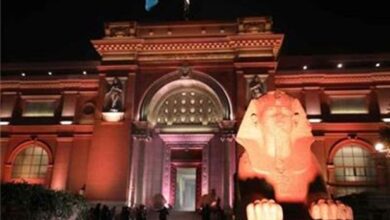In 1984, a renowned papyrus maker, Hussam Ragab, opened the world’s first living museum, the Pharaonic Village on the island of Qorsaya, in Giza. His boundless ambition led him to research the lives of the Ancient Egyptians and their habitat to the smallest details in order to establish a living museum that would realistically depict the everyday lives of the Egyptians 4,000 years ago.
Ragab already owned a part of the Island, where he was growing the world’s largest papyrus plantation. The iconic Egyptian plant had gradually disappeared during the industrial era, when new paper techniques invaded worldwide markets. His quest for papyrus seeds led him to Uganda and Ethiopia and the US, where he viewed an exhibition that retraced the lives of the first American settlers.
The American exhibition gave him the idea for creating a museum on Ancient Egyptian history, but a living one, with actors in costumes operating in a typically Pharaonic environment. Wael Sammir, the general manager of the Pharaonic Village, explained that Ragab’s first step was to “plant 5,000 trees all around the island to create a natural screen to shield the village from the city noises and concrete view.” From his incessant trips to Africa, Ragab brought back rare trees and exotic animals that were common to Egypt 4,000 years ago, creating a rich and lavish environment for the future village.
“The second step was to research the lifestyles, habits and traditions of the ancient Egyptians, in order to be as close to the historical reality as possible,” added Sammir. The Village currently employs 280 people, including 65 actors who dress in colorful costumes and perform daily tasks in the Pharaonic fashion.
Though the initial project was striking and ambitious, the actual living museum is deeply flawed. But, those flaws can be immensely funny.
The visit started with a 30-minute ferry promenade that takes you along the island’s shore. After passing white statues of the major Egyptian gods planted into the water, the boat continued its smooth sailing past reenactors in tacky white or striped garments with wide golden collars and jet black wigs who plow, fish and make pottery. There seemed to be a strict no-eye contact policy with the visitors, with the actors performing their tasks undisturbed by either the smirks or the genuine smiles of the meager audience on the boat. But as soon as the boat drifted relatively far away, they halted their activities, yawning and resuming playing the part of bored workers. A few white-washed mannequins in costumes are also installed here and there, possibly to make up for a reduced staff, giving the impression that particularly sleepy actors have turned into pillars of salt.
The ferry finally stalled and the viewers are invited to disembark before being rapidly ushered into a replica of the Karnak temple, guarded by a mean-looking priest covered in a shiny plastic purple leopard skin suit. An affable guide provided the audience with some interesting pieces of information, like how to read the Pharaonic calendar painted on the ceiling, or pointing at the scrolls contained in rows in the walls which replicate ancient libraries. A French tourist, exclaimed loudly, “I thought that was a wine cellar!”
The highlight of the next stop, at the nobleman's house, was the tour of the toilets: a hole in the ground which the guide pointed out "was much more hygienic than our modern toilets, where you sit on the toilet seat and get germs.”
Perhaps the toilets were even less lavish in the peasant's house, an undecorated adobe and the next stop on our tour, but we didn't see them. In the courtyard, a woman sat crushing wheat grains between two massive rocks to produce thin flour, while the man of the house started a fire using a wooden bar carved with rounded crevices filled with linen oil and grass. In order to create a spark, he spinned a wooden stick in a crevice very quickly. In the Pharaonic Village, 2010, the linen oil and grass have been replaced by bits of matches in the crevice for an immediate, guaranteed result. The audience was mesmerized.
The pride and joy of the museum is undoubtedly the perfect replica of Tut Ankh Amun’s tomb as it was discovered by Howard Carter in 1922. Sammir, with a proud tone, explained that “all the measurements of the real tomb have been respected in our replica, millimeter by millimeter.” The visitors were invited to go down a narrow, barely-lit staircase, in order to reach the chamber filled with the young king’s treasures, including a golden chariot, a complexly carved armchair, and many statues and boats. Climbing another set of stairs will bring the visitor to a room with a wide hole that serves as a box to contain the pharaoh’s golden coffin. In celebration of Carter’s discovery of November 1922, access to this replica will be free until the 15 November. Sammir said, in a confiding tone, that the museum can normally charge up to US$250 for an hour of filming inside the tomb, as "there is nothing like it” (except, one assumes, the original).
At this point, the living museum broadens its scope to display other stages of Egyptian history, from mummification to Nasser and Sadat memorabilia. Fourteen museums are housed in the entire village, four of them focusing on the Pharaonic period–mummification, building of the pyramids, ancient traditions. Four other sub-museums–the Cleopatra Museum, the Coptic Museum, the Islamic Museum and the Napoleon Museum–depict later stages of Egyptian history.
Other museums focus on Egypt today, with a museum dedicated to each of these major political figures: Sadat, Nasser and Naguib. The exhibition space dedicated to Sadat showcases various items belonging to the late president, from his toothpaste and toothbrush to his nightgown and wedding photos. All these precious and rare items were donated by his widow, Jehan Sadat, and are exhibited on the walls and inside glass boxes.
Nasser’s museum, which, according to Sammir, is the only museum dedicated to the “Raiss" in Egypt, is filled to the ceilings with black and white photographs of the late president in the company of major politicians like Yasser Arafat and Fidel Castro, and boxer Mohamed Ali. A glass box contains Nasser's old radio and fragments of a moon rock immobilized in a plastic bubble and given to him as a present by America.
What these former heads of state have in common with the ancient pharaohs, one can only guess.




